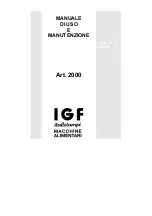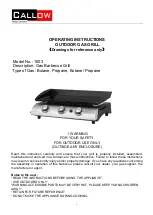
12
Preparation Before Cooking
To prevent foods from sticking to the cooking
surface, please use a long handled brush to
apply a light coat of cooking or vegetable oil
before each barbecuing session.
(Note:
When cooking for the first time, paint colours
may change slightly as a result. This is normal
and should be expected.)
Starting the Charcoal
Open the barbecue hood or lid before
lighting. Never light your barbecue with the
hood or lid closed.
Take the barbecue grills out of the barbecue
body.
Block Type Starters – Form charcoal in a
pyramid around it. Light the starter block.
When charcoal is well lit, using a heat
resistant tool, spread the charcoal around
the charcoal tray, adding more as
necessary.
Liquid Starters – Place charcoal in a shallow
tin. Pour liquid starter onto charcoal and wait
5-10 minutes to allow the starter to
penetrate into the charcoal. Then using a
heat resistant tool, place charcoal into the
charcoal tray in a pyramid formation.
Light the charcoal and allow time for it to
become well lit (red hot). Using a heat
resistant tool, spread charcoal in a uniform
layer, so that each lump is just touching.
The barbecue grills can now be replaced. Be
careful to keep yourself safely away from lit
charcoal.
When the charcoal is ashed over (grey
coating of ash over each lump) you are
ready to begin cooking.
It is recommended to operate the barbecue
with red-hot charcoal for at least 30 minutes
before use.
Do not cook before the fuel has a coating of
ash.
Do not attempt to cook whilst charcoal is
flaming.
Heat Control
The adjustable air vents on the hood can be
used to control the burning of the charcoal. With
the vents open, more air will circulate and the
charcoal will burn faster than with the vents
closed. Caution - the appliance may become
very hot. Oven gloves should always be used
when adjusting the vents. Do not close the hood
or lid whilst the charcoal is still flaming. Wait
until it has ashed over.
Grill Cooking
The food on the grill is cooked by the heat
produced from the hot charcoal below. The
natural food juices produced during cooking fall
onto the hot charcoal below and vaporise. The
subsequent rising smoke bastes the food, as it
travels upwards, imparting that
unique
barbecued flavour.
Roasting Hood Cooking
Barbecues equipped with a roasting hood give
the option to form an ‘oven’ for roasting or
baking food, such as joints of meat or whole
chickens, etc. More even cooking of food will
actually be achieved by using the barbecue with
the hood down.
Close the hood to cook the food ‘indirectly’.
Avoid lifting the hood unnecessarily as heat is
lost every time the hood is opened. If the hood
is opened during cooking please allow extra
time for the barbecue to regain its temperature
and complete the cooking. Use the temperature
gauge (if applicable) to monitor the heat of the
barbecue.
DO NOT ALLOW YOUR BARBECUE TO
OVERHEAT. Take care when opening the hood
as hot steam can be released on opening.
Flare-Up Control ** Very Important Notice **
Flare-ups occur when meat is barbecued and
its fat and juices fall upon the hot charcoal.
Smoke of course helps give food its barbecued
flavour, but it is best to avoid excessive flare-up
to prevent food being burned. To control flare-
ups, it is
ABSOLUTELY ESSENTIAL
to trim
away excess fat from meat and poultry before
grilling, use cooking sauces and marinades
sparingly and try to avoid very cheap cuts of
meat or meat products as these tend to have a
high fat and water content.
When flare-ups do occur, they can usually be
extinguished by applying baking soda or a salt
directly onto the charcoal. Always protect your
hands when handling anything near the cooking
surface of the barbecue and take care to protect
yourself from the flames.
If a fat fire occurs, please see the instructions
given below.
Fat Fires
Empty and clean the charcoal tray of food

































